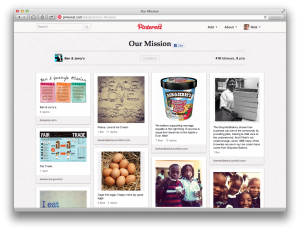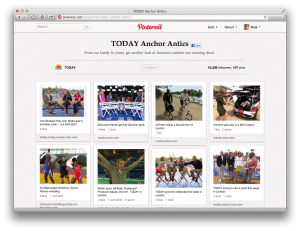With comScore clocking Pinterest’s growth rate at 4,000%, it remains the fastest growing social network in the world. With all of these new users jumping on board and pinning their hearts out, how can you ensure that your brand’s products and services are among the 40% of sales the network is expected to drive?
For starters, make sure Pinterest is a good fit for your brand. Remember, you don’t have to be active on every social network to be successful at social media. Moreover, your own success on Pinterest will be more likely if you have a strong strategy going out of the gate.
Many brands have quickly adopted Pinterest’s user-friendly social book-marking system, especially in the high fashion and home and garden sectors. But what if your brand’s fit isn’t as obvious as Real Simple or Kate Spade. What winning pinning strategies can you employ?
 1. Share Your History
1. Share Your History
Many company’s like Herman Miller and Southwest Airlines share images from the brands’ archives. Herman Miller shares old photos of its founding fathers while Southwest Airlines has a board of classic advertisements. Many brands have photos and memorabilia collecting dust in a storage closet. Clean it up, digitize it, and pin it!
 2. Spark Ideas
2. Spark Ideas
What if the product or service you provide doesn’t inherently have great visuals? No problem! Use Pinterest to curate others’ content from around the web and pin it to idea-inspiring boards like the Travel Channel does with its Trip Ideas board.
 3. Build on Your Brand’s Ethos
3. Build on Your Brand’s Ethos
Ben & Jerry’s does a lot right when it comes to social media (and ice cream, too!). Among their many boards is one dedicated to their mission, which features infographics, photos, and special products like Apple-y Ever After that supports the brand’s mission of social responsibility around the world.
 4. Encourage Inspiration & Aspiration
4. Encourage Inspiration & Aspiration
Not every pin needs to lead directly to a click to purchase. Sometimes you’re just building positive brand equity by providing inspiration and ideas for aspiration.
Real Simple has a board called Daily Thoughts & Inspiration which contain’s brightly colored images of engaging quotes and thoughts. Home decor brand West Elm offers a board updated daily, called Dream House of the Day. While your ROI may be more of a challenge to measure, you can’t go wrong building your customers up and encouraging their dreams.
 5. Provide Ideas for Product Use
5. Provide Ideas for Product Use
Our friends at Chobani have a board called Chobani’s Kitchen which features recipes and other creative Greek yogurt creations. Beyond recipes, you can show your clients what they can do with your product. If you sell office furniture, you could create a board configuring the same desk, chair, and accessories in different ways.
 6. Go Behind the Scenes
6. Go Behind the Scenes
A great use of visual content is taking your audience behind the scenes. That’s exactly what The Today Show does with their TODAY Anchor Antics board. You don’t have to be a show with actual scenes to go behind to employ this strategy. Take your Pinterest community inside your factory or into your back offices for exclusive access.
 7. Align Your Brand with Your Customers’ Lives
7. Align Your Brand with Your Customers’ Lives
It’s no secret that Pinterest has seen exceptional user adoption around major life events such as weddings and births. Wedding Republic has a board of Wedding Registry Ideas to help brides and grooms to be. Again, this doesn’t have to be limited to weddings. Is there a major life event you can tap into and build boards around?
 8. Drive Traffic to Web Content
8. Drive Traffic to Web Content
Closer to a more traditional measure of ROI, another use of Pinterest is driving traffic to web content. Better Homes & Gardens has a Style Spotters Blog that they push Pinterest traffic through by sharing content on a targeted board. As an experiment, I post each blog post here to a board on my profile called From the Blog: Brand Driven Insights. While it doesn’t make up a ton of traffic it’s still a legitimate part of my mix and could be for you too.
 9. Sell Things
9. Sell Things
Yes, this is possible too. However, it’s listed last to encourage you to look for other content to create and curate before simply pushing your product catalog to a board. While brands like Kate Spade New York are driving traffic to products with boards like Dress Colorfully, they’re doing so carefully and in addition to other curated boards as well. Also of note, though you can assign prices in Pinterest, the items without are twice as likely to get repinned or shared with others.
Ready to Repin?
With Pinterest, like so much on social media, there isn’t an easy way around doing the work. You can’t just set it and forget it. Instead, you need a strategy for on-going content and conversations you hope to create and curate around your brand, in hopes of building a brand driven community that leads to long-tail sales and lifetime customers.
Is your brand using Pinterest? If so, what’s your winning pinning strategy and how are you measuring success on the world’s fastest growing social network?

